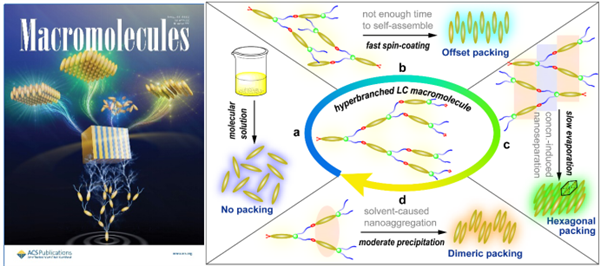The research work on hyperbranched liquid crystal polymers has been published online in "Macromolecules"
Hyperbranched polymers, due to their highly branched structure and internal irregularities, often struggle to form liquid crystals or ordered solid materials. Although introducing liquid crystal moieties into hyperbranched polymer systems can generate liquid crystalline phases, it is typically limited to low order nematic phases. There are few reports on higher ordered phases like smectic and columnar phases, severely restricting the diversity and application range of their assembly structures. Recently, the research group has reported a controllable assembly structure of hyperbranched liquid crystal polymers and investigated the influence of different processing methods on the molecular alignment and fluorescence properties of these polymers. Different forms of solid materials of hyperbranched liquid crystal polymers with varying fluorescence emissions can be obtained through precipitation, solvent evaporation, and spin-coating techniques. X-ray scattering structural studies have revealed that the significant fluorescence differences are mainly related to the arrangement of molecules in the smectic phases, with variations in intermolecular interactions leading to different degrees of π-orbital overlap and resulting in varying degrees of spectral redshift. These research findings provide effective guidance for the molecular design, assembly structure control, and optimization of liquid crystal polymer materials, and will also promote the preparation and application of novel optical materials under different conditions.

The research findings were published in "Macromolecules" (2020, DOI
10.1021/acs.macromol.0c00649).
Dr. Bin Mu, an assistant professor in the research group, is the first author of the paper, and Prof. Wei Tian is the corresponding author.
(Full article link: https://pubs.acs.org/doi/abs/10.1021/acs.macromol.0c00649#)